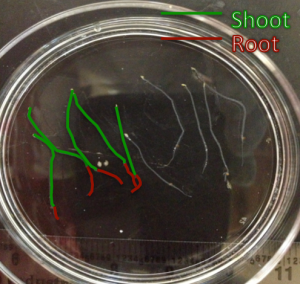In the past few months, the Gilroy Lab space biology research team has been busy analyzing data from our space-grown and Earth-grown control plants from our BRIC-17 TOAST experiment. Excitingly, we now have a full set of RNAseq data! The RNAseq is important to our analysis because it will give us insight into the differences in gene expression of plants grown in microgravity compared to ones grown on Earth and allow us to ask our big question: “Do plants grown on the ISS look like plants experiencing low oxygen stress on Earth”?
We presented some of our preliminary results at the American Society of Gravitational and Space Research meeting in Orlando at the end of last year. This meeting is the primary venue for space biology researchers to report their results to the rest of the space research community, a community that includes NASA-funded researchers who work for universities or for private companies. This was a fantastic meeting that included not only physicists and biologists who conduct research in microgravity but also NASA employees who run the research programs and engineers who develop hardware for research on the ISS. Hanging out with rocket scientists is an incredible amount of fun!
As a reminder, here are the primary questions we wanted to investigate for our BRIC-17 TOAST experiment growing plants on the space station. For more details about rationale and preliminary data leading to this experiment, see the “Experiment” details page.
- Do hypoxic (low oxygen) conditions develop in plants grown in microgravity aboard the ISS?
- Does cax2, a plant lacking a protein which transports calcium, allow for improved plant growth under these conditions?
First, we wanted to quantify any size differences between the plants grown in microgravity compared to ones grown on Earth. For this, Won-Gyu lined up the seedlings from each petri plate and took digital images. With help from an image analysis program, he measured the total size of each seedling and took individual size measurements from each shoot and each root.
It turns out that the cax2 mutant seedlings from the Space Station do show different sizes of roots and shoots, so it looks like at least some of our ideas about low oxygen stresses in space may be correct.
Second, Won-Gyu looked at changes in the expression of specific genes, genes which we know have altered expression levels in a plant experiencing low oxygen stress thanks to other Earth-based plant research. He did this analysis by isolating RNA from our seedlings and using quantitative PCR (qPCR) to detect how much RNA was present. Looking at the amount of transcribed message (mRNA) from these specific genes will give us insight into the magnitude of hypoxia experienced by plants grown in microgravity compared to Earth-grown seedlings. Again, it turns out that the level of some, but not all, genes related to low oxygen stress on Earth are altered in spaceflight and are different in the cax2 mutants from the Station. We are now in the the most exciting aspect of research; it looks like some of our predictions are correct but the plants are telling us something extra that we need to try and understand.
These qPCR experiments investigated a few select genes already characterized to be involved in the plant hypoxic response. However, the RNAseq data allows us to explore how spaceflight affected the levels of all 27,000 genes present in Arabidopsis. This RNAseq analysis is going to be the way we will tease apart what was going on to these plants aboard the ISS. As you can imagine, this set of data is huge (for the computer geeks out there, we have about 1 terabyte of raw data to sift through). Analyzing these results is in progress, but we hope to finish the work by the time spring arrives in Madison!





